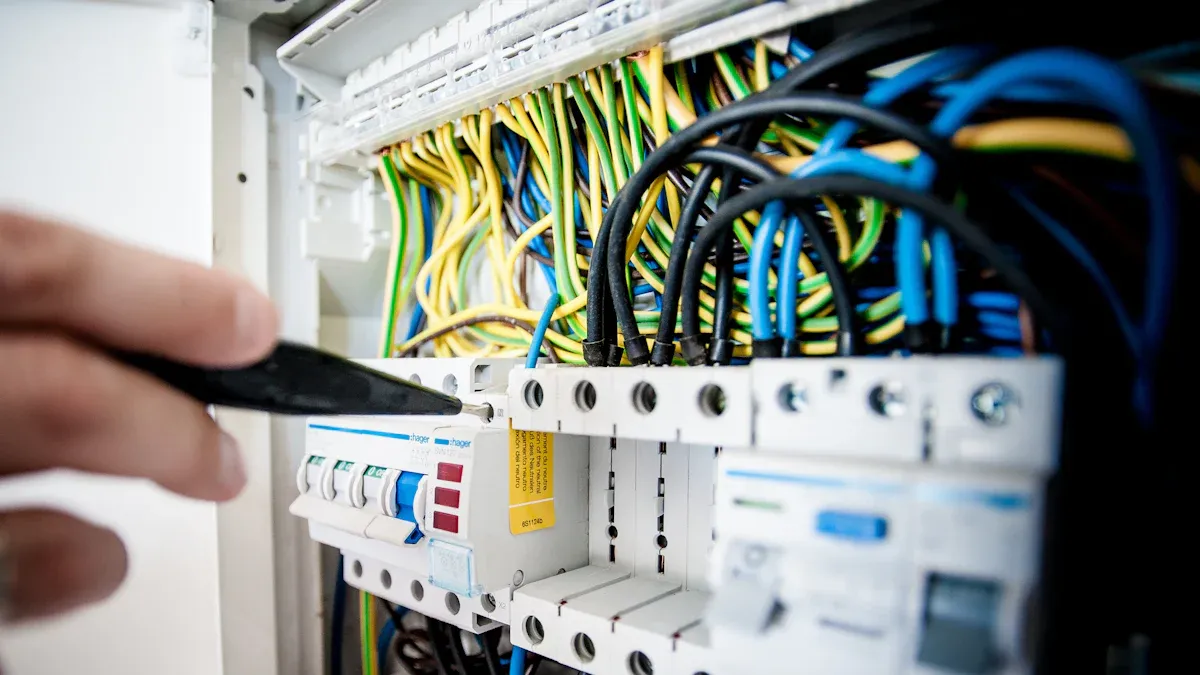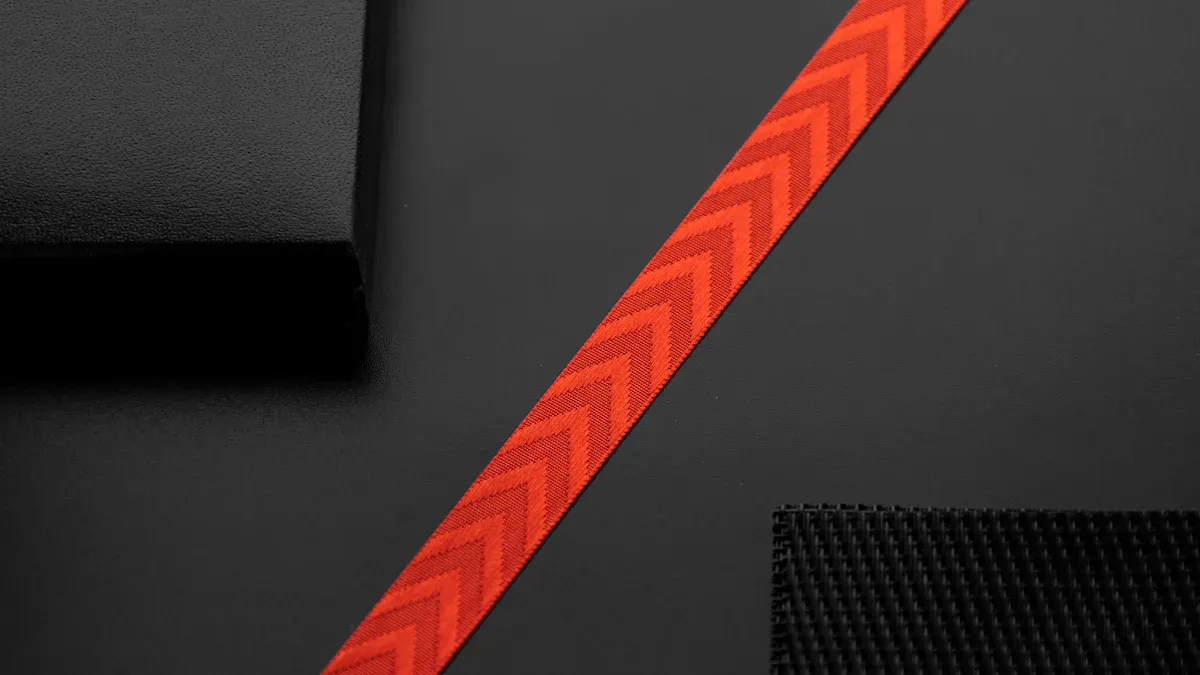Tips for Choosing PET Heat Shrink Tubing for Cable Harnessing

Choosing the right PET heat shrink tubing for cable harnessing ensures durability, safety, and optimal performance in demanding applications. Its exceptional mechanical strength resists tearing and cracking, even under pressure. The tubing maintains integrity during repeated bending and stretching, crucial for long-lasting installations. It protects wires from friction damage and withstands extreme temperatures without losing its protective qualities. Additionally, its resistance to chemicals, moisture, and UV rays enhances durability across diverse environments. Fire resistance further elevates safety, making it a reliable solution for industrial, automotive, and aerospace needs.
Key Takeaways
Pick the correct size and shrink ratio for PET tubing. Measure cable and connector widths before choosing the tubing.
Keep the temperature steady at 150°C (302°F) when shrinking. This helps the tubing fit well and avoids damage.
Use good tools like a heat gun with settings and sharp scissors. These help make the job neat and easy.
PET tubing is strong against chemicals and weather, so it works well for factories, cars, and medical uses.
Prepare cables and heat the tubing evenly to make it last longer and work better.
Key Factors for Selecting PET Heat Shrink Tubing
Importance of Size and Shrink Ratio
Selecting the correct size and shrink ratio is crucial when choosing PET heat shrink tubing for cable harnessing. The tubing must fit snugly over the cable or wire without being too loose or excessively tight. A proper fit ensures optimal insulation and protection. The shrink ratio, which indicates how much the tubing will reduce in size when heated, plays a significant role in achieving this fit. Common shrink ratios include 2:1, 3:1, and 4:1, with higher ratios accommodating larger size variations.
Tip: Measure the diameter of the cable and any connectors before selecting the tubing. This ensures the tubing will shrink to the desired size without compromising performance.
Using ultra thin wall PET heat shrink tubing can be advantageous in applications requiring minimal bulk while maintaining durability. This type of tubing is ideal for compact spaces where traditional tubing may not fit. Always verify the shrink ratio and tubing dimensions to avoid installation issues and ensure long-term reliability.
Material Properties to Consider
The best materials for heat shrink tubing combine durability, flexibility, and resistance to environmental factors. PET heat shrink tubing offers several advantages due to its material properties:
Reliable electrical insulation, making it suitable for various applications.
Excellent biocompatibility, maintaining structural integrity during sterilization processes, which is crucial for medical devices.
Versatility in thermal management and electrical insulation, aligning with specific application needs.
PET heat shrink tubing also provides excellent value by balancing affordability with high performance. It meets stringent medical and industrial standards, ensuring safety and functionality. Manufacturers should verify material compatibility with relevant standards to minimize risks and enhance reliability.
Chemical and Environmental Resistance
PET heat shrink tubing excels in chemical and environmental resistance, making it a preferred choice for demanding applications. Its ability to withstand harsh conditions ensures long-lasting performance. The following table highlights key properties:
Property | Description |
|---|---|
Chemical Resistance | Excellent resistance to solvents, oils, and cleaning agents, protecting device components from degradation. |
Sterilization Resistance | Withstands gamma radiation, ethylene oxide, and other methods without losing structural integrity. |
Biocompatibility | Meets ISO 10993 standards, ensuring minimal adverse reactions in patient-facing applications. |
This tubing retains its mechanical properties even after repeated sterilization cycles. It effectively resists high-temperature steam, gamma radiation, and ethylene oxide exposure. These qualities make it suitable for medical, industrial, and automotive applications.
PET heat shrink tubing meets stringent biocompatibility standards (ISO 10993).
It undergoes evaluations for cytotoxicity, irritation, and sensitization.
It ensures safe use in contact with bodily tissues or fluids.
When selecting adhesive-lined heat shrink tubing, consider its ability to provide a watertight seal. This feature enhances protection against moisture and contaminants, further extending the lifespan of the cable harness.
Temperature and Application Compatibility

Temperature Tolerance for Shrinking
PET heat shrink tubing requires precise temperature control to achieve optimal shrinkage and maintain its mechanical properties. The effective shrinking temperature typically ranges from 70°C (158°F) to 190°C (374°F). For most applications, 150°C (302°F) serves as the ideal temperature. Heating the tubing within this range ensures a secure fit over cables and wires while preserving its durability.
Tip: Use a heat gun with adjustable settings to maintain consistent temperatures during installation. This prevents uneven shrinking and potential damage to the tubing.
Proper temperature tolerance not only enhances the tubing's performance but also reduces the risk of cracking or deformation. Overheating or underheating can compromise the tubing's protective qualities, making precise temperature control essential for reliable results.
Matching Tubing to Application Conditions
Selecting PET heat shrink tubing that aligns with specific application conditions ensures long-term performance. Medical-grade tubing, for instance, must endure extreme temperatures ranging from -196°C to 200°C without losing functionality. This capability makes it suitable for demanding environments such as sterilization processes and cryogenic applications.
High-performance PET tubing also demonstrates exceptional reliability in industrial and automotive settings. It withstands harsh conditions, including exposure to chemicals, moisture, and UV rays. Matching the tubing's properties to the intended environment guarantees durability and safety.
Note: Always verify the tubing's temperature range and environmental resistance before installation to avoid premature failure.
Preventing Overheating or Underheating
Achieving a smooth and uniform shrink requires careful temperature management. Overheating can cause the tubing to become brittle or discolored, while underheating may result in incomplete shrinkage. Both scenarios reduce the effectiveness of the cable harness.
To prevent these issues, technicians should:
Use heat sources with precise temperature controls.
Monitor the tubing closely during the shrinking process.
Avoid prolonged exposure to heat in one area to ensure even shrinkage.
Maintaining the correct temperature not only enhances the tubing's mechanical properties but also extends the lifespan of the cable harness. Proper installation techniques play a critical role in achieving optimal results.
Best Practices for Installing Heat Shrink Tubing
Preparing the Cable Harness
Proper preparation of the cable harness is essential for installing heat shrink tubing effectively. A well-prepared harness ensures a secure fit and enhances the tubing's protective capabilities. The following steps outline the preparation process:
Use calipers to measure the diameter of the wire or component that requires insulation.
Calculate the appropriate size of the heat shrink tubing based on the measured diameter and the tubing's shrink ratio.
Measure and cut the tubing to the required length using sharp scissors to ensure clean edges.
Slide the tubing over the wire or component, ensuring it covers the desired area completely.
Use a hot air gun to apply heat evenly, activating the tubing's shrinking properties.
Allow the tubing to cool before handling to maintain its shape and integrity.
Tip: Always double-check the measurements before cutting the tubing to avoid wastage and ensure a precise fit.
By following these steps, technicians can ensure the tubing fits snugly, providing optimal insulation and protecting wiring from environmental factors.
Choosing the Right Tools for Installation
Selecting the appropriate tools is critical for achieving a smooth and efficient installation. High-quality tools not only simplify the process but also ensure the tubing performs as intended. The table below highlights key performance characteristics to consider when choosing tools for installing heat shrink tubing:
Performance Characteristic | Description |
|---|---|
Shrink Ratio | PET heat shrink tubing comes in various shrink ratios (e.g., 2:1, 4:1), ensuring proper coverage of irregular shapes. |
Material Quality | High-quality PET tubing offers superior tensile strength, chemical resistance, and thermal stability. |
Regulatory Compliance | Compliance with standards like ISO 10993 ensures biocompatibility and safety for medical applications. |
A heat gun with adjustable temperature settings is the most effective tool for shrinking the tubing. It allows precise control over the heat application, preventing overheating or underheating. Scissors or a sharp blade is essential for cutting the tubing to the correct length. Additionally, calipers help measure the wire diameter accurately, ensuring the tubing fits perfectly.
Note: Avoid using open flames, as they can cause uneven shrinking or damage the tubing.
Techniques for Achieving a Smooth Shrink
Achieving a smooth and uniform shrink requires careful attention to technique. Uneven shrinking can compromise the tubing's protective properties and reduce its lifespan. To ensure a professional finish, technicians should follow these guidelines:
Apply heat evenly across the tubing's surface using a heat gun. Move the gun in a continuous motion to avoid overheating specific areas.
Begin heating from the center of the tubing and work outward toward the edges. This method prevents air bubbles from forming under the tubing.
Maintain a consistent distance between the heat gun and the tubing to ensure uniform heat distribution.
Monitor the tubing closely during the process to identify any irregularities and adjust the heat application as needed.
Tip: Allow the tubing to cool completely before handling to avoid deforming its shape.
By mastering these techniques, technicians can ensure the tubing provides a secure and durable fit, effectively protecting wiring from environmental and mechanical stress.
Applications of PET Heat Shrink Tubing

Industrial Cable Harnessing
PET heat shrink tubing plays a vital role in industrial cable harnessing. Its durability and resistance to environmental stress make it ideal for protecting cables in manufacturing facilities, power plants, and other demanding environments. The tubing shields wires from abrasion, moisture, and chemical exposure, ensuring uninterrupted operations. Its ability to withstand high temperatures and mechanical stress enhances reliability in heavy-duty applications.
Industries often use adhesive-lined PET heat shrink tubing to create watertight seals, safeguarding cables from contaminants. This feature is particularly beneficial in environments with frequent exposure to oil, solvents, or corrosive substances. By maintaining the integrity of cable harnesses, PET heat shrink tubing reduces maintenance costs and minimizes downtime.
Automotive Wiring Solutions
Automotive wiring systems demand robust protection against heat, vibration, and exposure to fluids. PET heat shrink tubing offers a reliable solution for insulating and organizing wiring in vehicles. Its high-temperature tolerance ensures performance in engine compartments, where temperatures can reach extreme levels.
The tubing’s chemical resistance protects wiring from automotive fluids such as oil and coolant. Its flexibility allows it to conform to complex wiring layouts, ensuring a secure fit. Automotive manufacturers often use PET heat shrink tubing for cable harnessing in electric vehicles, where precise insulation is critical for safety and efficiency.
Tip: Using tubing with a higher shrink ratio accommodates connectors and irregular shapes commonly found in automotive wiring systems.
Electronics and Consumer Devices
PET heat shrink tubing is widely adopted in electronics and consumer devices due to its versatility and reliability. It provides insulation for wires and components, preventing short circuits and enhancing safety. The tubing’s thin walls and transparency make it suitable for compact devices, where space is limited.
Market analysis highlights the growing use of PET heat shrink tubing in electronic equipment. Trends show increased adoption driven by its ability to protect sensitive components from environmental factors such as moisture and UV rays. Consumer devices, including smartphones and wearable technology, benefit from the tubing’s lightweight and durable properties.
Manufacturers prioritize PET heat shrink tubing for cable harnessing in electronics due to its compliance with industry standards and cost-effectiveness. Its role in ensuring device longevity and performance underscores its importance in this sector.
Selecting the right PET heat shrink tubing involves careful consideration of several critical factors. These include size, shrink ratio, material properties, and temperature requirements. To summarize:
Choosing the Correct Size: Ensure the tubing’s pre-shrink diameter is no more than 15% larger than the component’s maximum diameter to prevent uneven shrinkage.
Mastering Shrink Temperature Settings: Maintain a recommended temperature of 150°C (302°F) for most applications, within a range of 70°C–190°C (158°F–374°F).
Controlling Shrinkage: Limit total shrinkage to 15%–20% and hold the tubing ends during heating to avoid lengthwise contraction.
Preventing Wrinkles: Apply tension on both ends of the tubing during heating to achieve a smooth finish.
Aligning tubing selection with specific application needs ensures optimal performance. For instance, materials like GP70-TPV offer superior chemical resistance and flexibility, while HS-105 PVC provides flame retardancy and compatibility with various chemicals.
Material | Temperature Range | Chemical Resistance | Flexibility | Flame Retardant |
|---|---|---|---|---|
GP70-TPV | -60° to 135°C | Superior | High | No |
HS-105 PVC | - | Many chemicals and oils | - | Yes |
Prioritizing quality and compatibility enhances durability and safety across applications. By following these guidelines, users can achieve reliable, long-lasting cable harnessing solutions.
FAQ
What is the difference between PET heat shrink tubing and PVC heat shrink tubing?
PET heat shrink tubing offers superior chemical resistance, higher temperature tolerance, and greater durability compared to PVC. PVC tubing, however, is more cost-effective and provides flame retardancy. The choice depends on the application’s environmental and performance requirements.
Tip: Use PET tubing for demanding environments and PVC for general-purpose applications.
How do I determine the correct shrink ratio for my application?
The shrink ratio depends on the size variation of the components being covered. For example:
2:1: Suitable for uniform cables.
3:1 or 4:1: Ideal for irregular shapes or connectors.
Measure the largest and smallest diameters to select the appropriate ratio.
Can PET heat shrink tubing be reused after removal?
No, PET heat shrink tubing cannot be reused. Once it shrinks, it conforms permanently to the component’s shape. Removing it typically damages the tubing, making it unsuitable for reuse.
Note: Always measure and cut carefully to avoid waste.
Is PET heat shrink tubing safe for outdoor use?
Yes, PET heat shrink tubing resists UV rays, moisture, and extreme temperatures, making it suitable for outdoor applications. Its durability ensures long-term protection for cables exposed to harsh environmental conditions.
What tools are essential for installing PET heat shrink tubing?
Key tools include:
Heat gun: For controlled and even heating.
Calipers: To measure cable diameters accurately.
Sharp scissors: For clean cuts.
Avoid open flames to prevent uneven shrinking or damage.
Reminder: Use tools with adjustable settings for precise results.
See Also
Selecting The Ideal Ultra-Thin PET Heat Shrink Tubing
A Comprehensive Guide To Selecting Heat Shrink Tubing Size
Key Advice For Effectively Utilizing FEP Heat Shrink Tubing
Important Information Regarding PET Heat Shrink Tubing In Electronics
Applications Of Heat Shrink Tubing For Electrical Wire Insulation

